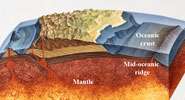Diamonds show how Earth is recycled

(PhysOrg.com) -- Tiny minerals found inside diamonds have provided us with a rare glimpse of the Earth’s deepest secrets. This exciting new research by a team of scientists, led by the University of Bristol, is reported today (30 July) in Nature.
The Earth’s crust that underlies our oceans is constantly being made at mid-oceanic ridges which run down the centre of our oceans. There, magma derived from the mantle (the layer beneath the crust) is injected between diverging tectonic plates, pushing them apart. On the far side of each plate, old oceanic crust is eventually recycled by returning it to the mantle at subduction zones, huge trenches that dive deep beneath the continents.
Dr Michael Walter, from the Department of Earth Sciences at the University of Bristol, and lead author on the paper, said: “Exactly what happens to subducted oceanic crust is a long-standing question in Earth Sciences. Seismic imaging of subducted slabs has provided strong evidence that it can be taken to great depths, possibly even to the core-mantle boundary some 2,900 km below the Earth’s surface. There it can remain for billions of years in a kind of crustal graveyard. Its ultimate fate, however, remains uncertain.”
Dr Walter added: “There is also strong geochemical evidence that after stewing in the mantle for a very long time, say a billion years or so, oceanic crust acquires an isotopic ‘flavouring’ that is very different from the surrounding mantle. If this crust somehow makes its way into regions of the mantle that undergo melting, the new magmas will betray the ‘scent’ of ancient oceanic crust.”
But many questions remain as to exactly how oceanic crust yields its unique signature to magmas. Does solid crust waft around in the mantle forming a sort of marble cake that can then be melted? Or does the crust melt at great depth within the mantle and react with mantle rocks to form some sort of hybrid source rock?
Given the depths these rocks are taken to, neither of these possibilities seemed likely, since the pressures would be too high for rocks to melt at those depths. However, the team has found evidence from tiny mineral inclusions in diamonds that suggests oceanic crust can melt deep in the mantle and in this way imbue its flavouring into surrounding mantle rocks.
The rock that is erupted on the ocean floor (basalt) spends most of its life (hundreds of millions of years) exposed to seawater. Consequently, some portion of it reacts with the seawater to form carbonate minerals. The team speculated that the presence of these minerals in oceanic crust has the effect of lowering its melting point to temperatures much lower than that of the surrounding mantle.
Although there is not much carbonate in oceanic crust so only a little melt can be formed, this small-degree melt will be loaded with elements that carry a chemical signature of the crust. Subsequent melting of mantle rocks that contain these small carbonate melts (carbonatites) would then yield magmas that also carry the crustal signature. But how to prove this?
Diamonds require high pressures to form. As such, they provide clues to the Earth’s deep interior, well beyond the depths that can be directly accessed by drilling. As the carbonate-rich liquids ascend through the mantle, diamonds crystallise en route, trapping other minerals (inclusions) as they form. The team therefore studied diamonds from the Juina area in Brazil, a location famous for yielding diamonds with inclusions derived from the deep mantle.
After performing a large number of experiments, measurements and calculations, the researchers were able to show that the diamonds and their inclusions had indeed crystallized from very small-degree, carbonatite melts in the mantle. Furthermore, they speculate, such melts may be pervasive throughout the mantle and may have been imparting a crustal ‘stain’ on mantle rocks for a very long time.
Citation: Primary carbonatite melt from deeply subducted oceanic crust by M. Walter, G. Bulanova, L. Armstrong, S. Keshav, J. Blundy, G. Gudfinnsson, O. Lord, A. Lennie, S.M. Clark, C. Smith, and L. Gobbo. Nature, 31 July 2008.
Provided by University of Bristol




















